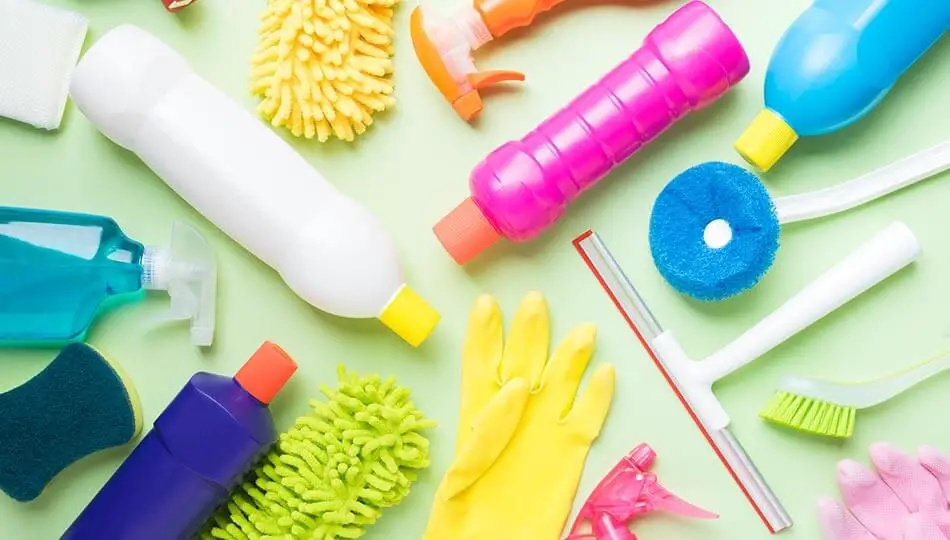Last Updated on August 6, 2023 By Emma W. Thomas
Cleaning agents work by breaking down dirt, grease, and stains on surfaces. They contain surfactants that reduce the surface tension of water, allowing the cleaning solution to penetrate and lift away debris, resulting in a cleaner and more sanitized environment.
Top 10 Cleaning Agents and Their Uses
| No. | Cleaning Agent | Uses |
|---|---|---|
| 1. | Ammonia | This is commonly used as a multi-purpose cleaner. It is commonly used for cleaning floor tiles, glass, and jewelry. |
| 2. | Bleach (Sodium Hypochlorite) | It’s a potent disinfecting and whitening agent, often used for laundry, disinfecting surfaces, and removing stains. |
| 3. | Vinegar (Acetic Acid) | Known for its natural cleaning properties, it is utilized for removing mold, mildew, cleaning windows, and brightening up coffee pots. |
| 4. | Borax (Sodium Borate) | This chemical compound is used in laundry detergents, disinfectants, and also effective in killing insects. |
| 5. | Hydrogen Peroxide | This is a safe cleaning agent used for cleaning cuts, disinfecting surfaces, and as a bleaching agent. |
| 6. | Baking Soda (Sodium Bicarbonate) | It is used as an odor neutralizer, a mild scrubber for tough stains, and an ingredient in homemade laundry detergent. |
| 7. | Alcohol (Isopropyl) | This is a versatile cleaning agent used for disinfecting surfaces, cleaning electronics, and removing sticky substances. |
| 8. | Soap (Sodium Stearate) | Soap is primarily used for cleaning dishes, laundry, and personal hygiene. |
| 9. | Detergent (Sodium Laureth Sulfate) | These play a vital role in washing clothes, cleaning kitchen utensils, and bathroom cleaning. |
| 10. | Acetone | It is commonly used for removing nail polish, cleaning brushes, and dissolving super-glue. |
What Are The Four Cleaning Agents?

Cleaning agents are classified into four broad categories according to their cleaning mechanism and chemical properties. Each type has its specified use in housekeeping or cleaning procedures. Learning how to handle correctly and use each cleaning agent is crucial to any housekeeper. Understanding their appropriate use will ensure you get the most out of your cleaning activities. The four categories of cleaning agents are:
- Detergents
- Degreasers
- Acids
- Abrasives
Summary Of Cleaning Agents And How Each Works
| Cleaning Agent | How It Works |
| Detergents | Loosening dirt and breaking it down into small particles that are easy to wash away. Reducing surface tension of water making it more permeable |
| Degreasers | Breaking down grease, oil, and grime for easy cleaning |
| Acids | Dissolving tough stains and mineral deposits leaving clean and stainless surfaces |
| Abrasives | Extensive rubbing to scratch away unwanted substances |
Detergents
Detergents are substances containing surfactants and soaps and are the most popular cleaning agents in any home or establishment. They are used for easy and hard cleaning tasks, including dishwashing, hand washing, laundry, and softening fabrics. You can find detergents in the form of liquids, powders, crystals, blocks, and gels. Most detergents are synthetic and are made from petroleum products.
Detergents work by reducing water’s surface tension, making it spread or get into surfaces more easily. Detergents also contain surfactants that loosen dirt on garments and surfaces and break it down into small particles that are easier to wash away.
Safety precautions when using detergents
- Before using any chemical detergent, check the ingredients list. Some detergents contain chemical fragrances that are likely to cause allergic reactions. Always ensure the fragrance concentration doesn’t exceed 0.01% by weight of the detergent.
- When checking the ingredients list, check for phosphorous amounts in the detergent. Phosphorous is a toxic chemical and should not be more than 0.5 grams in any detergent.
- Store detergents in their original containers with labels on them.
- Never mix detergent with ammonia or other household cleaners since the chemical reaction can release dangerous fumes
- Store detergents out of reach of children since ingestion can cause poisoning.
Degreasers
Degreasers are cleaning agents mostly used in commercial kitchens to remove grease, grime, and oil from hard surfaces. You can use degreasers to clean ovens, grills, metal surfaces, and heavily soiled floors. Some common ingredients in degreasers that help to break down fats are:
- Sodium Carbonate (soap ash)
- Ethylenediaminetetraacetate (EDTA)
- Kerosene
- Methylated spirits
- Sodium Meta Silicate
- Xylene
- Sodium Tripolyphosphate
Fats, grease, and oils are organic dirt that can be broken down by alkaline solvents. Degreasers are alkaline in nature, making them break down grease quickly. There are different categories of degreasers, and each has a different pH. Heavy-duty degreasers are more alkaline (higher pH) while light cleaners have neutral pH.
Safety Precautions When Using Degreasers
- Read instructions on product packaging to ensure you use degreasers correctly
- Degreasers are highly-alkaline and can be corrosive; thus, housekeepers need to wear safety gloves when handling them and use them only on recommended surfaces
- Some degreasers contain lye or ammonia; when using such, do not mix with bleach since they produce a poisonous chlorine gas
- Use high-alkaline degreasers in well-ventilated areas with eye and skin protection to prevent chemical burns
- When shopping for degreasers, go for those that are non-fuming, non-toxic, and environmentally friendly
Acids
Acid cleaners are highly concentrated solutions that can be corrosive and dangerous. They work by dissolving stains and dirt, thus breaking them down for easier cleaning. Acids are used for the most challenging cleaning tasks to dissolve ingrained grime and dissolve mineral deposits.
Different acid cleaners have other uses based on their strength. Lemon juice and vinegar are mild acids used for household tasks such as removing hard-water deposits from glassware. Sulfuric and hydrochloric acids are strong acids used as toilet bowl cleaners and rust removers.
Acid cleaners have a wide range of uses such as:
- Cleaning bathroom tiles
- Removing rust and tough stains
- Removing mold
- Restoring discolored and tarnished metal
- Descaling mineral deposits
- Cleaning masonry
Safety Precautions When Using Acid Cleaners
- Acid cleaning agents are toxic, and the manufacturer’s instructions need to be read and followed
- When using acid cleaners, avoid contact with the skin and eyes
- Use only in well-ventilated rooms
- Do not mix acid cleaners with other cleaning agents
- Always wear protective gear such as masks when cleaning with strong acids
Abrasives
Abrasives are cleaning agents that are used to remove dirt and stains from hard surfaces. They work by extensive rubbing to scratch away unwanted substances. Abrasives are commonly used on floors, kitchen sinks, surfaces, bathrooms, and pavements. Abrasives can be in the form of powders with grit, steel wool pads, pumice stones, or scrubby pads. In most cases, abrasives are used to restore surfaces where other mild cleaning agents have failed.
Abrasives contain minerals or particles which contribute to their effectiveness. Some of the common ingredients in abrasive cleaners are:
- Calcium carbonate
- Aluminum oxide
- Quartz
- Calcite
- Whiting
- Silica
Some abrasives also contain disinfectants that help to kill bacteria. Those abrasives containing disinfectant always have a label to indicate so. Some common disinfectants used with abrasives are sodium hypochlorite, quaternary ammonium compounds, and pine oil.
Safety Tips When Using Abrasives
- Always read the instructions on the packaging before using any abrasive
- Do not use abrasives on natural stone surfaces or marble
- Ensure you test abrasives on a small inconspicuous area of the surface before using it on the entire surface
- Use abrasives sparingly and rub gently
- Never leave abrasives to dry out on the surface you are cleaning as this might leave stains
Useful Tips When Using Any Cleaning Agent

After basic cleaning using the appropriate cleaning agent, you need to sanitize your surfaces. Cleaning is effective in removing germs and dirt but sanitizing helps to get rid of bacteria and microorganisms. Following your cleaning with sanitizing helps to prevent cross-contamination, allergic reactions, and pest infestations.
Sometimes in your cleaning routine, you will face a task that requires special treatment. In this section, we take you through those particular tasks and their treatment solutions. Keep reading!
| Cleaning Ask | Specialty Cleaning Agent |
| Removing mold or mildew stains from clothes | diluted sodium hypochlorite (household bleach) |
| Unclogging kitchen sink from grease and fat | Sodium hydroxide |
| Removing mineral salt stains from glass or mirrors | Vinegar /acetic acid |
| Removing rust, limescale, or hard water stains | Weak acids such as citric acid/ hydro acetic acid dissolve minerals |
| Cleaning tarnished metal | Fine hydrous silica |
| Unclogging bathroom drainage clogged with hair and soap | Sodium hydroxide and sodium hypochlorite |
Final Word
Cleaning agents are useful in making our cleaning tasks less cumbersome. They help to remove dirt and stains more quickly as compared to just using water. You need to know the right cleaning agent for a specific task to get the best results. Knowing how cleaning agents works comes in handy in helping you settle for what to use.
Always ensure you take precautions and read instructions carefully before using a cleaning agent. Wear safety gear to protect your skin from irritation and work in a ventilated room. Nowadays, we have cleaning agents that are eco-friendly and safer to use. Always go for the least toxic product you can find. Ensure you read the ingredients to ensure products don’t contain allergens or harmful substances. When storing cleaning agents, ensure they are in their appropriate containers and are clearly labeled to avoid accidents. It would be best if you also kept cleaning agents in locked cabinets out of reach of children.
In case a cleaning agent comes into contact with your eyes or is ingested, flush out with lots of water, and seek medical attention. Using cleaning agents appropriately and safely makes cleaning more comfortable and more enjoyable. We hope this post is helpful to you, and that you will use the right cleaning agent to keep your home clean and sanitary.
References:
https://www.multi-clean.com/chemistry-works-how-do-cleaning-products-work/
https://www.homedit.com/cleaning/what-are-cleaning-agents/
Emma is a graduate of Domestic Science or Family and Consumer Sciences (Home Economics) from the University of Wisconsin. She has 7 years of experience Working with the strategic section of BestBuy and now writing full-time for Homeeon.
From Managing the Home, Interiors, Cleaning, and Exteriors to Gardening and everything about Making A Home Liveable – is her passion and this Homeeon is the result of this.
Emma loves decorating her home with the best stuff found online. She cares about quality over anything and writes reviews about them here in Homeeon. Get in touch with her over Pinterest.
Keep reading her blogs.

